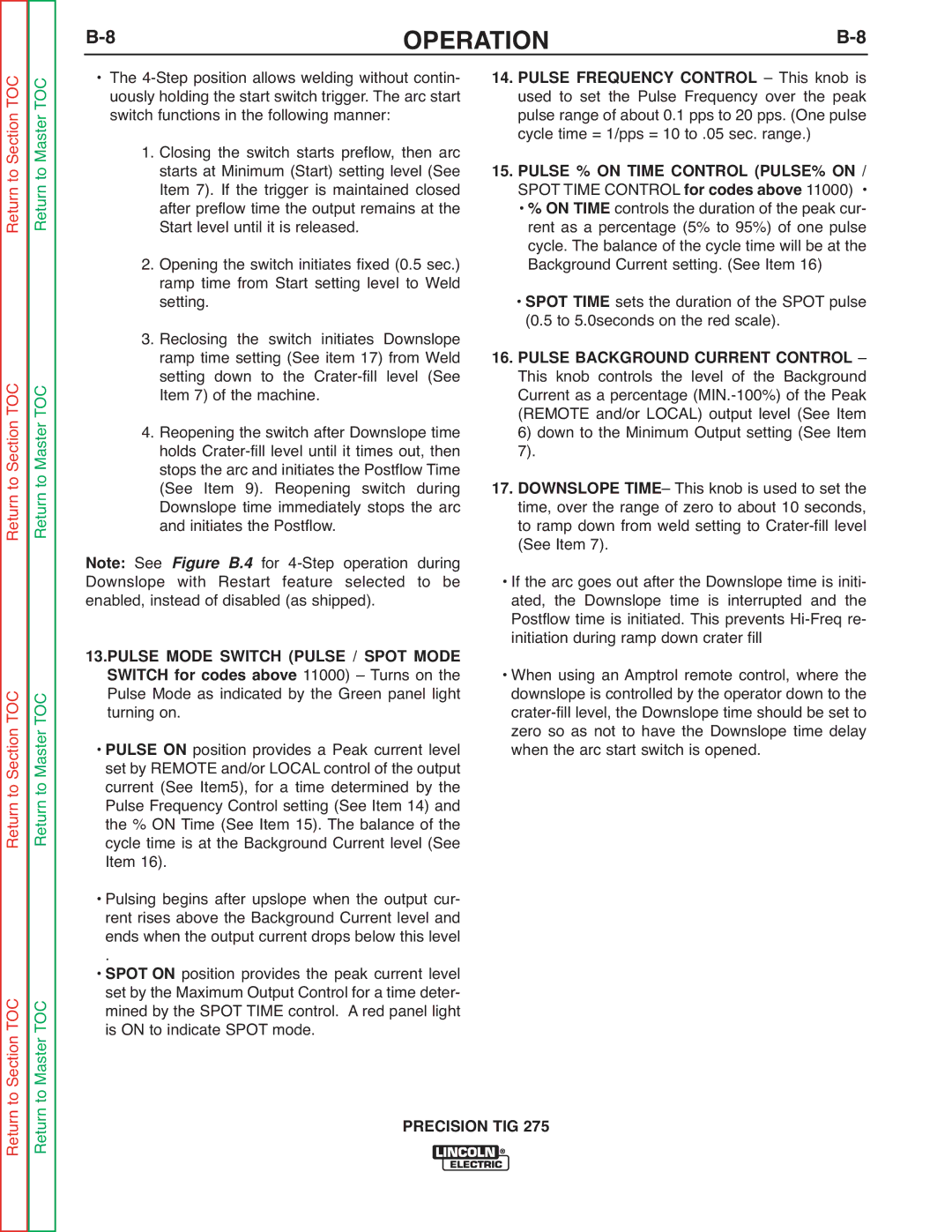
Return to Section TOC Return to Master TOC
Return to Section TOC Return to Master TOC
Return to Section TOC Return to Master TOC
Return to Section TOC Return to Master TOC
OPERATION |
| ||||
• The | 14. PULSE FREQUENCY CONTROL | – This knob is | |||
uously holding the start switch trigger. The arc start | used to set the Pulse Frequency over the peak | ||||
switch functions in the following manner: | pulse range of about 0.1 pps to 20 pps. (One pulse | ||||
| 1. Closing the switch starts preflow, then arc | cycle time = 1/pps = 10 to .05 sec. range.) | |||
| starts at Minimum (Start) setting level (See | 15. PULSE % | TIME CONTROL (PULSE% ON / | ||
| Item 7). If the trigger is maintained closed | SPOT TIMECONTROL for codes above 11000) • | |||
| after preflow time the output remains at the | • % ON TIME controls the duration of the peak cur- | |||
| Start level until it is released. | rent as a percentage (5% to 95%) of one pulse | |||
| 2. Opening the switch initiates fixed (0.5 sec.) | cycle. The balance of the cycle time will be at the | |||
| Background Current setting. (See Item 16) | ||||
| ramp time from Start setting level to Weld | • SPOT TIME sets the duration of the SPOT pulse | |||
| setting. | ||||
| 3. Reclosing the switch initiates Downslope | (0.5 to 5.0seconds on the red scale). | |||
| ramp time setting (See item 17) from Weld | 16. PULSE BACKGROUND CURRENT CONTROL – | |||
| setting down to the | This knob controls the level of the Background | |||
| Item 7) of the machine. | Current as a percentage | |||
| 4. Reopening the switch after Downslope time | (REMOTE and/or LOCAL) output level (See Item | |||
| 6) | down to the Minimum Output setting (See Item | |||
| holds | 7). |
|
|
|
| stops the arc and initiates the Postflow Time | 17. DOWNSLOPE TIME– This knob is used to set the | |||
| (See Item 9). Reopening switch during | ||||
| Downslope time immediately stops the arc | time, over the range of zero to about 10 seconds, | |||
Note: | and initiates the Postflow. | to ramp down from weld setting to | |||
See Figure B.4 for | (See Item 7). |
|
| ||
Downslope with Restart feature selected to be | • If the arc goes out after the Downslope time is initi- | ||||
enabled, instead of disabled (as shipped). | ated, the Downslope time is interrupted and the | ||||
|
| Postflow time is initiated. This prevents | |||
SWITCH for codes above 11000) – Turns on the | initiation during ramp down crater fill |
| |||
• When using an Amptrol remote control, where the | |||||
13.PULSE MODE SWITCH (PULSE / SPOT MODE | downslope is controlled by the operator down to the | ||||
Pulse Mode as indicated by the Green panel light | |||||
turning on. | |||||
• PULSE ON position provides a Peak current level | zero so as not to have the Downslope time delay | ||||
when the arc start switch is opened. |
| ||||
set by REMOTE and/or LOCAL control of the output |
|
|
|
| |
current (See Item5), for a time determined by the |
|
|
|
| |
Pulse Frequency Control setting (See Item 14) and |
|
|
|
| |
the % ON Time (See Item 15). The balance of the |
|
|
|
| |
cycle time is at the Background Current level (See |
|
|
|
| |
Item 16). |
|
|
|
| |
• Pulsing begins after upslope when the output cur- rent rises above the Background Current level and ends when the output current drops below this level
• .SPOT ON position provides the peak current level set by the Maximum Output Control for a time deter- mined by the SPOT TIME control. A red panel light is ON to indicate SPOT mode.
PRECISION TIG 275
